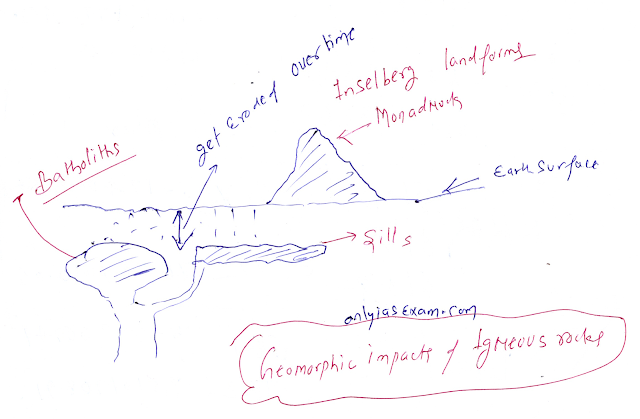Question.
Classify rocks according to the mode of their formation. Give the characteristics of igneous rocks and assess their geomorphic impacts. ( UPPSC 1994)
Answer.
Rocks are made up of different minerals and do not have a definite chemical composition. Rocks are a basic unit of the crust and the Earth's crust comprises different types of rocks.
According to the mode of formation, there are three types of rocks:
- Igneous rock
- Sedimentary rock
- Metamorphic rock
Metamorphic rocks are formed by the recrystallization of igneous and sedimentary rocks under the action of pressure, volume, and temperature (PVT). For example, limestone (sedimentary rock) turns into marble (metamorphic rock), and clay (sedimentary rock) turns into slate (metamorphic rock) under PVT.
Sedimentary rocks are formed by the process of sedimentation. Loose sediments compact and harden to form layers of rocks. For example, sandstone is made up of small particles of sand.
Igneous rocks are also known as primary rocks because they form after molten magma cools. Through the volcanic activity, magma (which comes from the asthenosphere) cools from within the Earth's surface to form igneous rock.
Features of Igneous rocks:
- The basic structure of igneous rocks is that of magma which is mainly composed of silica and magnesium elements.
- Extrusive igneous rocks (formed after the lava has cooled on the Earth's surface) that are formed due to the rapid cooling of lava have a very fine-grained structure. For example, basalt igneous rocks.
- Intrusive igneous rocks (formed by the cooling of magma in the depths of the Earth) are the size of large grains of these rocks due to the slow cooling of magma. For example, granite rocks.
- Inbuilt igneous rocks are harder than exogenous igneous rocks.
- Igneous rocks are the major inputs for metamorphism and sedimentary rock formation.
- Igneous rocks do not contain any fossils.
- Igneous rocks are the source of valuable mineral sources like gold, copper, etc.
Role of Igneous Rocks for the formation of Landforms:
- Igneous rocks are harder than other rocks and are therefore resistant to erosion.
- Monadnock or Inselberg or isolated hills are important landforms of igneous rocks.
- Sills (built-in volcanic landforms) are bed beds formed by igneous rocks.
- Batholiths are large igneous rocks that appear on the Earth's surface due to surface erosion.
You may like also:

ConversionConversion EmoticonEmoticon